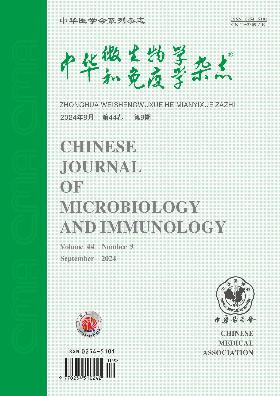Molecular cloning and expression of OspA peptide from a Chinese Borrelia garinii strain PD91 and preliminary study on its immunoprotectivity
Q4 Immunology and Microbiology
引用次数: 0
Abstract
Objective To clone and express the 126-274 aa OspA peptide (OspA-pep) of Chinese Borrelia garinii (B.garinii) strain PD91 and to preliminarily study its immune protectivity. Methods The gene encoding the 126-274 aa OspA-pep of B. garinii PD91 was amplified by polymerase chain reaction (PCR) and then cloned into the prokaryotic expression vector pET-30a to construct the recombinant plasmid pET-30a-OspA-pep. Escherichia coli BL21 (DE3) competent cells transfected with the recombinant plasmid were induced by IPTG to express the target protein. The recombinant OspA-pep (rOspA-pep) was purified with Ni-IDA resin chromatography and its immunogenicity was analyzed by Western blot. New Zealand white rabbits were immunized with different doses of rOspA-pep (20, 30, 40, 50, 60, 80 and 100 μg). The titers of specific IgG antibodies in rabbit serum samples before and after immunization were detected by indirect immunofluorescence assay (IFA). The optimal immune dose was determined according to the antibody titer after immunization. In vitro neutralization test was performed to detect the immune protection of rOspA-pep using serum samples of the optimal immunization group. The optimal dose of rOspA-pep was used to immunize New Zealand white rabbits to observe the changes in antibody titer. Results The recombinant plasmid pET-30a-OspA-pep was successfully constructed and highly expressed in host bacteria. Western blot showed that rOspA-pep had obvious antigen-antibody reaction with polyclonal antibody against B. garinii PD91 strain. IFA results showed the titers of IgG antibody in serum samples of rabbits immunized with rOspA-pep increased significantly (up to 1∶2 480) and 40 μg was the optimal dose. The neutralization rates of antibodies induced by 40 μg of rOspA-pep were 100% against 106 strain/ml of representative B. garinii PD91 and Borrelia afzelii (B.afzelii) FP1 strains, 100% against 107 strain/ml of FP1 strain, and 60% against 107 strain/ml of PD91 strain. After immunization with 40 μg rOspA-pep on 1 d and 30 d, the titers of specific IgG antibody in rabbit serum samples reached the peak within two months, and maintained at that level for about 3-4 months before a gradual decline. Conclusions The 126-274 aa OspA peptide fragment of Chinese B. garinii PD91 strain possessed good immunogenicity and induced antibodies with better in vitro neutralizing activity, which suggested that it could be used as a candidate component of the second generation subunit vaccine in China. Key words: Borrelia garinii; OspA peptide; Cloning and expression; Immunoprotectivity中国加里氏疏螺旋体PD91株OspA肽的克隆、表达及其免疫保护作用的初步研究
目的克隆并表达中国加里伯氏疏螺旋体(B.garinii)菌株PD91的126-274 aa OspA肽(OspA-pep),并初步研究其免疫保护作用。方法采用聚合酶链反应(PCR)扩增出加里尼布氏杆菌PD91 126-274 aa OspA-pep基因,并将其克隆到原核表达载体pET-30a中,构建重组质粒pET-30a-OspA-pep。用IPTG诱导转染重组质粒的大肠杆菌BL21 (DE3)感受态细胞表达目的蛋白。重组OspA-pep (rOspA-pep)采用Ni-IDA树脂层析纯化,Western blot检测其免疫原性。用不同剂量的rOspA-pep(20、30、40、50、60、80、100 μg)免疫新西兰大白兔。采用间接免疫荧光法(IFA)检测免疫前后兔血清中特异性IgG抗体的滴度。根据免疫后抗体滴度确定最佳免疫剂量。采用体外中和试验检测最佳免疫组血清样品的免疫保护作用。采用最佳剂量的rOspA-pep免疫新西兰大白兔,观察抗体效价的变化。结果成功构建了重组质粒pET-30a-OspA-pep,并在宿主菌中高表达。Western blot结果显示,rOspA-pep与加里尼布氏杆菌PD91多克隆抗体存在明显的抗原抗体反应。IFA结果显示,经rOspA-pep免疫的家兔血清中IgG抗体滴度显著升高(达1∶2 480),最佳剂量为40 μg。40 μg rOspA-pep对代表性布氏加里尼布氏杆菌PD91和阿夫泽利伯氏疏螺旋体FP1菌株106株/ml的抗体中和率为100%,对FP1菌株107株/ml的抗体中和率为100%,对PD91菌株107株/ml的抗体中和率为60%。40 μg rOspA-pep免疫1 d和30 d后,兔血清样品中特异性IgG抗体滴度在2个月内达到峰值,并在3-4个月左右维持该水平,随后逐渐下降。结论中国加里尼布氏杆菌PD91菌株126-274 aa OspA肽片段具有良好的免疫原性,诱导的抗体具有较好的体外中和活性,可作为中国第二代亚单位疫苗的候选组分。关键词:加里氏疏螺旋体;OspA肽;克隆与表达;Immunoprotectivity
本文章由计算机程序翻译,如有差异,请以英文原文为准。
求助全文
约1分钟内获得全文
求助全文
来源期刊

中华微生物学和免疫学杂志
Immunology and Microbiology-Virology
CiteScore
0.50
自引率
0.00%
发文量
6906
期刊介绍:
Chinese Journal of Microbiology and Immunology established in 1981. It is one of the series of journal sponsored by Chinese Medical Association. The aim of this journal is to spread and exchange the scientific achievements and practical experience in order to promote the development of medical microbiology and immunology. Its main contents comprise academic thesis, brief reports, reviews, summaries, news of meetings, book reviews and trends of home and abroad in this field. The distinguishing feature of the journal is to give the priority to the reports on the research of basic theory, and take account of the reports on clinical and practical skills.
 求助内容:
求助内容: 应助结果提醒方式:
应助结果提醒方式:


